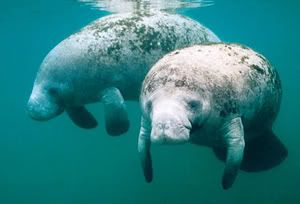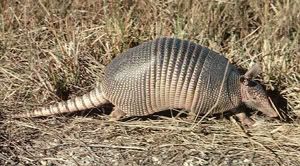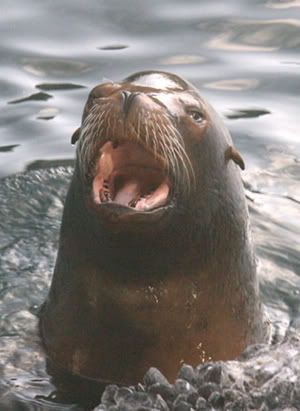Manatees can remain submerged for up to 15 minutes but usually surface to breathe every 3-5 minutes.

Manatees are docile creatures and have no natural predators. Recreational boat propellers account for many manatee injuries and deaths.
They migrate seasonally. During the warmer months, the Florida manatee is found in bays and estuaries along both coasts. During cooler months, unable to tolerate water temperatures below 65°F, manatees congregate in large groups in warm waters, such as spring-fed rivers and industrial plant outflows.
Diet consists of sea- and bank grasses, mangrove, and submerged and floating vegetation.
Breeding occurs at any time of the year, but most often in spring and summer. The calf, weighing 30-60 pounds, is born 12-13 months later and will remain with the mother for up to two years.
Man is the only predator of adult manatees. Calves are preyed on by alligators, crocodiles, and sharks.

Nine-banded Armadillo, (Dasypus novemcinctus), introduced to Florida in the early 1900’s, is found state-wide in areas with dense ground cover and sandy soil. It is covered with stiff, bony plates. Nine bands of plates cover the body from shoulder to hip and 12 bands cover the long tail. It has a small, tapered head and snout and a long tongue. Its ears are long and hairless. It has sparse white hairs on its belly. Armadillos are the only mammals in Florida with an exoskeleton.
It is primarily nocturnal, sedentary, solitary, and a burrower. It digs a series of dens. The multiple entrances are usually protected by stumps, palmettos, or trees. Many other animals also use armadillo dens.
Its diet is composed of insects, especially beetles, and other invertebrates plus some plant foods.
Armadillos breed in July or August. Each litter is composed of identical quadruplets, the result of a single egg splitting. All are either male or female. Litters are usually born in March or April. The young begin following the mother the day they are born.
When pursued, an armadillo can dig a burrow and disappear in just a few seconds. The nine-banded armadillo cannot roll into a ball to protect itself but a South American armadillo can.
Predators include man, dogs, bobcats, coyotes, black bears, panthers, and foxes.
A small percentage of armadillos carry leprosy.

Harbor Seal, (Phoca vitulina), are found in inlets, harbours, and estuaries on the Atlantic coast as far south as Volusia County. It is light to dark gray, often mottled. It has large eyes and prominent whiskers. It is 5-6 feet long.
It migrates seasonally. It forages in shallow water for fish and shellfish.
It breeds in September. One or two pups are born the following spring.
Predators include killer whales, sharks, polar bears, and man.
Seals are carnivorous marine mammals. They have four flipperlike limbs with five webbed digits on each limb. Their bodies are streamlined, external ears are very small or nonexistent, and nostrils are narrow. They are clumsy on land.

No comments yet.